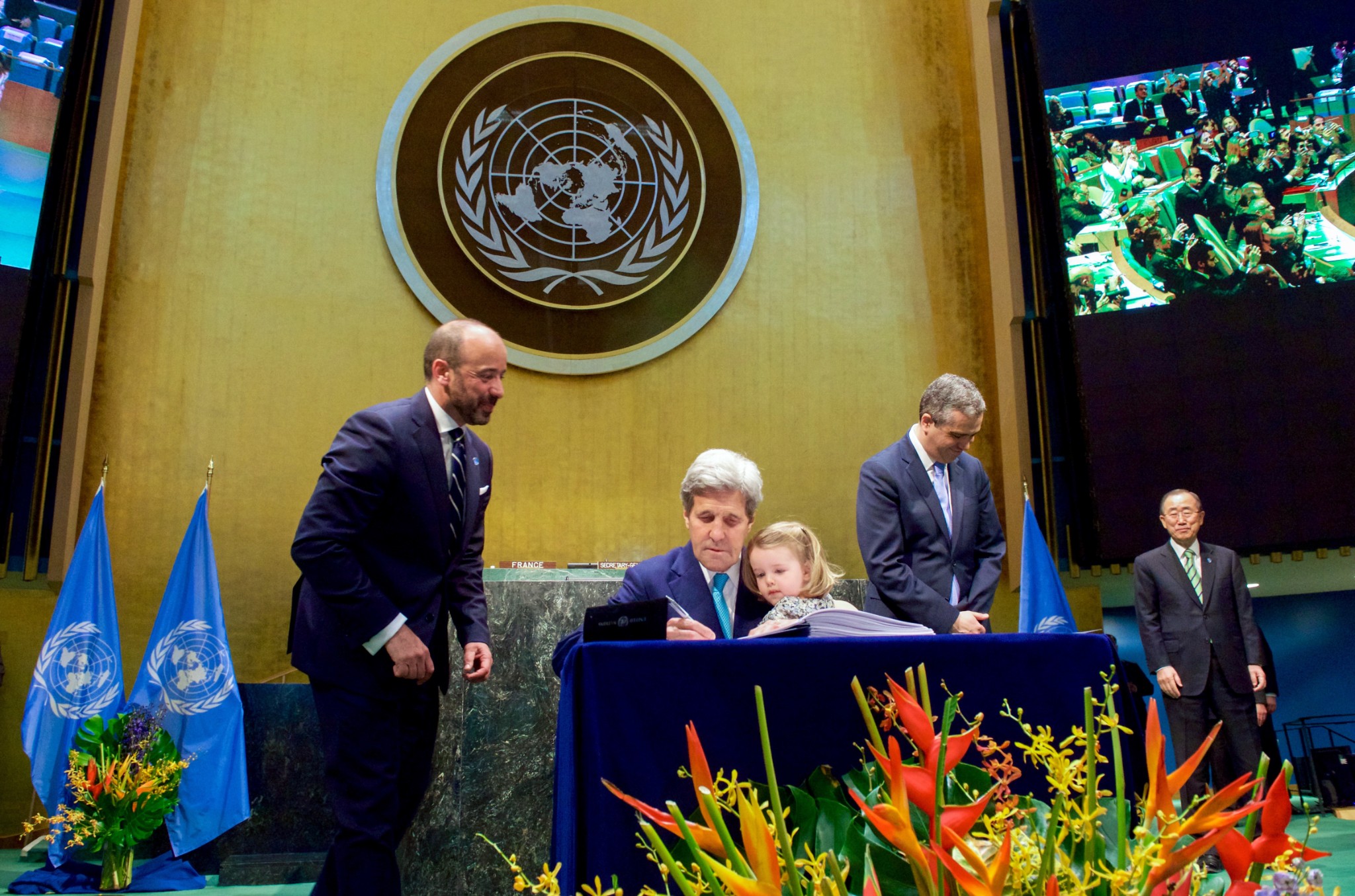 Secretary John Kerry signing the Paris Agreement | Credit: U.S Dept. of State
Secretary John Kerry signing the Paris Agreement | Credit: U.S Dept. of State
Facing the Heat: Addressing the Threat of Heat Domes
This is the second post in a series addressing the increasing security threats of heat domes and how to approach them moving forward. Heat domes form as shifts in wind trap hot air below, which then settles on land as a heat wave. The first piece identified the rising frequency and risk of heat domes, discussing the associated negative impacts on human health and the agricultural industry during the June 2021 extreme heat wave in the Pacific Northwest.
Scientists identified climate change as the driving force behind the June 2021 heat dome and they expect it will cause more events of this nature in the future. To address the security risk heat domes pose, the United States must employ a series of mitigation and prevention policies to minimize the threat of extreme heat and limit the rate these dangerous events occur.
Preventing Future Heat Domes
The Environmental Protection Agency has identified a steady increase in the frequency and length of heat waves since the 1960s. This trend is the result of an increase in greenhouse gases (GHGs) that trap heat in the atmosphere. The burning of oil and coal for energy has increased the atmospheric concentration of GHGs by 48% since the Industrial Revolution.
To reverse the increased absorption of heat in the atmosphere, every sector must reduce their emissions and increase energy efficiency where possible while also employing cleaner sources of energy production. The Paris Agreement, signed in December 2015, is one of the top global initiatives spurring counties to reverse rising temperatures. 191 parties signed the legally binding document, pledging to lower their GHG emission levels to limit the global rise in temperature to under 1.5 degrees. A 2021 study analyzed the Nationally Determined Contributions (NDCs) of signees to track their pledges for lowering emission levels. The report found that by 2030, the total decrease in emissions from NDCs would be around 1%, compared to the 45% decline needed to meet the 1.5-degree limit goal.
To reach the set goals, the United States and other members must create climate-resilient systems that reduce climate change impacts and employ risk management as part of the energy development process. Distributed energy resources (DERs) generate and store energy through technologies that include solar panels, turbines, and waste-to-power facilities. Smart-grids are another beneficial tool that allow for more sustainable electricity transfers between facilities and consumers. Both are viable solutions for clean energy production and use.
Mitigating the Effects of Rising Temperatures
Lowering GHG emissions to limit the global rise in temperature is going to take intergovernmental collaboration and public-private partnerships—and, as the Paris Agreement is revealing, will take significant time to accomplish. In the meantime, mitigation strategies can reduce the threat of extreme heat on human and economic security.
Cities can form heat islands, typically during the summer months, in which they experience more intense temperatures and severe impacts from heat domes compared to non-urban areas. This is the result of unshaded pavements and buildings that absorb and radiate heat into the air, causing temperatures of up to 15 degrees Fahrenheit warmer than surrounding non-urban areas. Resilience techniques such as green roofs, and increased tree cover are effective strategies for cooling cities during heat waves. Energy use multiplies during heat waves when air conditioning units have to work harder for longer periods, which then compounds these challenges and requires the production of more energy, thus increasing GHG emissions. These cooling techniques limit the need for excess energy use. Resilience strategies combined with the installation of cleaner and more efficient energy sources will allow the U.S. to lower their GHG emissions while addressing the current intense temperatures experienced.
Addressing the Effects on Agriculture
The previous post also shed light on the threat heat domes have on the agricultural system and economy in the Pacific Northwest. As temperatures increase, the agricultural industry will need to adjust to protect workers and yields. Paid breaks, water, shaded areas, and medical resources should be employed to mitigate injuries to those vulnerable workers. As crop yields and revenue are affected by rapid increases in temperature, the United States Department of Agriculture (USDA) recommends farms extend growing seasons, increase the efficiency of irrigation and fertilizer systems and schedules, and alter crop population to reduce crop demands for water and nutrients in order to build resilience against a heat dome. By preparing for abnormally hot and dry weeks through longer growing seasons and more efficient irrigation, farms will lose fewer products and revenue.
Where does this leave us?
Rising temperatures present an imminent threat to human and economic security. As heat domes become more intense and more regular, policies to mitigate their effects and prevent future ones from occurring are essential. The Paris Agreement, especially now that the U.S. has rejoined, is a crucial first step, but the road ahead is long. While shifting towards cleaner sources of energy, it is equally important to prepare communities to deal with the heat domes that are coming. By addressing both prevention and mitigation strategies, it is possible to protect against the rising heat.





